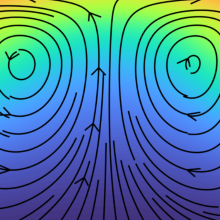New SFB 1313 publication (University of Stuttgart), published in AIP Physics of Fluids. The work has been developed within SFB 1313 research project A05.
Authors
- Leon H. Kloker (former student of the University of Stuttgart)
- Carina Bringedal (University of Stuttgart, SFB 1313 research project A05)
Abstract
This work considers the gravitational instability of a saline boundary layer formed by an evaporation-induced flow through a fully saturated porous slab. Evaporation of saline waters can result in the formation of salt lakes as salt accumulates near the top surface. As gravitational instabilities can impede the accumulation of salt, establishing a relation between their occurrence and the value of physical parameters such as evaporation rate is crucial. One step toward determining when gravitational instabilities can arise is to compute the ground-state salinity. In this work, this ground state is analytically derived within the framework of Sturm–Liouville theory. Then, a linear stability analysis in conjunction with the quasi-steady state approach is employed to investigate the occurrence of instabilities. These instabilities can develop and grow over time depending on the Rayleigh number and the dimensionless height of the porous medium. To calculate the critical Rayleigh number, which is used to determine the stability of a particular system, the eigenvalues of the linear perturbation equations have to be computed. Here, a novel fundamental matrix method is proposed to solve this perturbation eigenvalue problem and shown to coincide with an established Chebyshev–Galerkin method in their shared range of applicability. Finally, a two-dimensional direct numerical simulation of the full equation system via the finite volume method is employed to validate the time of onset of convective instabilities predicted by the linear theory. Moreover, the fully nonlinear convection patterns are analyzed.

Carina Bringedal
Ass. Prof. Dr.Associated Researcher, Research Project A05
[Photo: Max Kovalenko]


